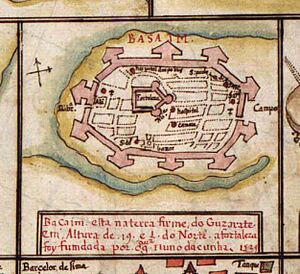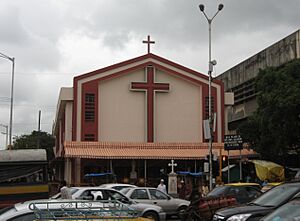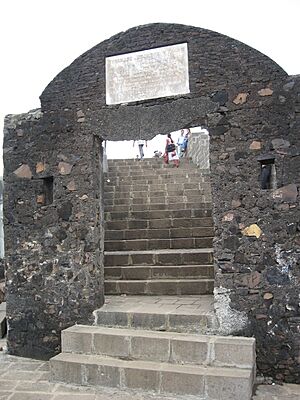History of Bombay under Portuguese rule (1534–1661) facts for kids
Bombay, also known as Mumbai today, is a huge, busy city in India. It's a major center for money and business, and it's also home to the famous Bollywood film industry. Long ago, when the Portuguese first arrived, Bombay wasn't one big city. It was actually a group of seven separate islands!
For many centuries, different Hindu rulers controlled these islands. Then, in the 1300s, Muslim rulers from the Delhi Sultanate took over the area, including Bombay. Later, the Sultan of Gujarat gained control. In 1534, the Sultan of Gujarat signed a special agreement called the Treaty of Bassein. He was worried about the powerful Mughal emperor, Humayun. So, he gave the seven islands of Bombay and other important places like Bassein to the Portuguese. The Portuguese officially took control in 1535.
The Portuguese, especially their religious groups like the Franciscans and Jesuits, helped build many churches in Bombay. Some famous ones include St. Michael's Church in Mahim and St. John the Baptist Church in Andheri. They also built strong forts like the Bombay Castle and the Madh Fort to protect the city.
In 1661, a marriage treaty was signed between King Charles II of England and Catherine de Braganza, who was the daughter of the King of Portugal. As part of Catherine's dowry (a gift of money or property given by the bride's family to the groom), the seven islands of Bombay were given to the English Crown. The English East India Company later leased the islands from King Charles II in 1668 for a small rent. This was because the islands were seen as a bit of a burden to the king. The English wanted Bombay because its harbor was very safe from land attacks, unlike other cities. However, the Portuguese governor in Goa didn't fully hand over all the islands right away. It took until 1739 for the English East India Company to fully control all seven islands.
Contents
How the Portuguese Arrived
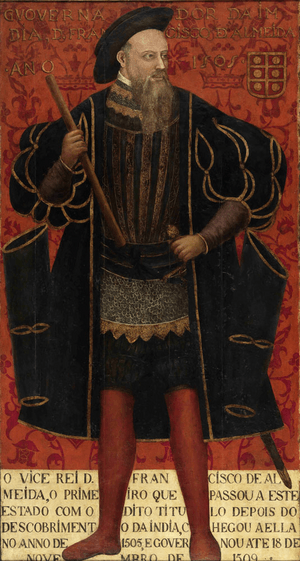
Before the Portuguese, Bombay's islands were ruled by many different groups. These included the Mauryas, Satavahanas, and Silharas. By 1534, the islands were under the control of Sultan Bahadur Shah of Gujarat. At that time, Bombay was an archipelago (a group of islands) made up of seven main islands. These were Bombay Island, Parel, Mazagaon, Mahim, Colaba, Worli, and Old Woman's Island.
The Portuguese explorers first reached the west coast of India in 1498 with Vasco da Gama. They slowly gained power in the region. In 1510, they captured Goa, which became a very important base for them.
In December 1508, the Portuguese explorer Francisco de Almeida sailed into Bombay Harbour. The Portuguese first landed on the islands in January 1509, at Mahim. They wanted to build a fort there, but the Sultan of Gujarat didn't agree at first.
Over the next few years, the Portuguese continued to fight with the Gujarat Sultanate. In 1526, they set up a trading post in Bassein, a town near Bombay. In 1528, they captured the fort of Mahim. The Portuguese kept attacking towns like Thana and Mahim. Because of their victories, the islands of Bombay and Mahim, along with Bandra, became places that had to pay taxes to the Portuguese.
Bombay Becomes Portuguese
The Mughal Empire was a very strong power in India during the 1500s. It was founded by Babur in 1526. After Babur died, his son Humayun became emperor.
Sultan Bahadur Shah of Gujarat was worried about Humayun's growing power. So, he decided to make a deal with the Portuguese. He offered to give them the seven islands of Bombay, along with Bassein and its surrounding areas.
On December 23, 1534, the Treaty of Bassein was signed. This agreement officially gave Bassein and the seven islands of Bombay to the Portuguese. The islands were fully handed over on October 25, 1535. This marked the end of Muslim rule over the islands and the beginning of Portuguese control.
Developing the Islands
After 1534, the Portuguese started leasing out the islands of Bombay to different officers. Bombay Island itself was leased to a person named Mestre Diogo. Mahim and Mazagon were also rented out.
The Portuguese built many churches in Bombay. St. Michael's Church in Mahim, built in 1534, is the oldest Portuguese Franciscan church there. The Portuguese also brought their religion, Roman Catholicism, to the islands. They encouraged local people to convert to Christianity.
The Portuguese called the islands by different names, like Mombai and Bombai. Eventually, the name Bombaim became common in Portuguese. When the British took over, they changed it to Bombay.
In the mid-1500s, the seven islands of Bombay were leased to Garcia de Orta. He was a Portuguese doctor and botanist. He built a large house in Bombay, which later became the Bombay Castle. Orta wrote about the islands and the people living there.
The main groups of people living in Bombay were the Kolis, who were fishermen. There were also farmers called Kunbis and Agris, and gardeners called Malis. Some people, called Piaes, were like soldiers. The Prabhus collected rents and were merchants. Muslims in Bombay were mainly involved in sea trade. There were also some Christian families.
The Portuguese built several forts to protect the city. The Madh Fort was an important one in Salsette. In 1640, they built the Castella da Aguada (Fort of the Waterpoint) in Bandra. This fort was a watchtower that looked over the sea and the nearby islands. It had cannons for defense.
The Portuguese encouraged marriage between their people and the local population. They also strongly supported the Roman Catholic Church. They converted many local people to Christianity. These new Christians were sometimes called "Portuguese Christians." Later, they became known as "East Indian Catholics" during the British rule.
In 1580, Portugal and Spain joined under one ruler. This made it easier for other European countries, like the Dutch and the British, to explore trade routes to India. The British arrived in Bombay in 1583. They noticed that Bassein and Thana were trading in rice and corn. Bombay's main trade at that time was coconuts.
In 1612, the British fought the Portuguese in the Battle of Swally near Surat. The British won, which was a big step in ending the Portuguese control over trade in western India.
End of Portuguese Control
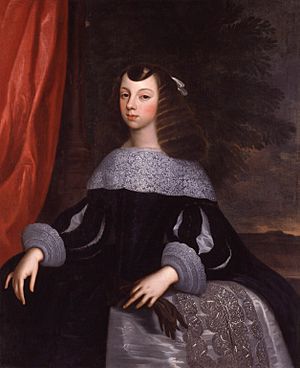
By the mid-1600s, the British East India Company saw how valuable Bombay was. They wanted to buy it from the Portuguese. They told the British government that Bombay had an excellent harbor and was safe from land attacks.
On May 11, 1661, a marriage treaty was signed. King Charles II of England married Catherine of Braganza, the daughter of the King of Portugal. As part of Catherine's dowry, Bombay was given to the British Empire.
In March 1662, Abraham Shipman was appointed as the first British Governor of Bombay. He arrived in Bombay later that year. However, the Portuguese Governor refused to hand over all the islands. He argued that only Bombay Island was part of the treaty, not the nearby islands like Salsette.
The Portuguese Viceroy in Goa also refused to help. So, Shipman couldn't land in Bombay and had to go to another island called Anjediva. He died there in 1664. His replacement, Humphrey Cooke, finally agreed to accept only Bombay Island in November 1664. He also agreed to give special rights to Portuguese citizens and protect the Roman Catholic religion.
Even after this, many islands like Salsette, Mazagaon, and Parel remained under Portuguese control. It wasn't until 1739, after a battle, that the English East India Company finally gained full control of all the islands of Bombay.
See also
- History of Mumbai
- Portuguese India
- British Bombay
- Indo-Portuguese Creole of Bombay
Images for kids


